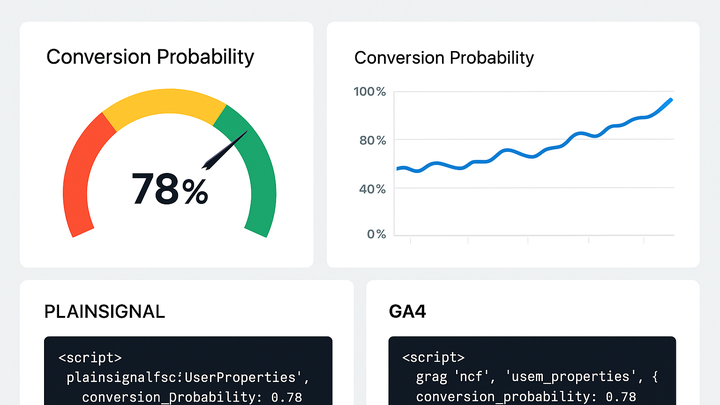Published on 2025-06-28T02:30:13Z
What is Conversion Probability? A Guide for Analytics Teams
Conversion probability is a forward-looking metric that estimates how likely a visitor is to complete a desired action—such as making a purchase, signing up for a newsletter, or requesting a demo. Unlike conversion rate, which looks backward at completed actions over total sessions, conversion probability uses historical and real-time behavioral data to assign each user a score (0–1 or 0–100%). Analytics platforms like Google Analytics 4 (GA4) offer built-in predictive metrics (e.g., purchase and churn probability), while cookie-free tools like PlainSignal can feed event streams into custom models. By surfacing which users are most likely to convert, teams can prioritize high-value audiences, personalize experiences, and optimize marketing spend. Conversion probability also powers predictive audiences, real-time bidding, and advanced segmentation for more targeted campaigns.
Conversion probability
Forward-looking score predicting a user’s likelihood to convert, used for targeting and optimization in GA4 or custom analytics.
Overview of Conversion Probability
Conversion probability assigns each user a likelihood score for completing a target action, helping teams move from reactive reporting to proactive outreach. It leverages patterns in clicks, pageviews, sessions, and past conversions to forecast future behavior. Scores typically range from 0 to 1 (or 0%–100%) and can be updated in real time as users interact with your site or app. By focusing on predicted converters, marketers can tailor campaigns, adjust budgets, and personalize experiences for maximum impact. Conversion probability bridges the gap between raw data and actionable insights, letting you act before conversions occur.
-
Definition
A predictive metric that quantifies the chance a user will complete a desired action within a given timeframe.
-
Conversion probability vs. conversion rate
Conversion rate measures past performance (conversions ÷ sessions), while conversion probability forecasts future behavior based on user signals.
-
Scoring scale
Scores are expressed on a 0–1 scale or as percentages; higher values indicate greater likelihood to convert.
How Conversion Probability Is Calculated
Models vary in complexity from simple rule-based approaches to advanced machine learning. Choice of model affects accuracy, interpretability, and data requirements. Understanding these methods helps you choose or build the right solution for your use case.
-
Rule-based models
Assign probabilities based on predefined thresholds (e.g., if users view >5 pages, set probability = 0.3). Quick to implement but lack nuance.
-
Statistical models
Use techniques like logistic regression to relate historical user features (age, location, pages viewed) to conversion outcomes.
-
Machine learning models
Employ algorithms such as random forests or gradient boosting trained on large event datasets for higher accuracy and feature discovery.
Conversion Probability in GA4
GA4 delivers built-in predictive metrics powered by Google’s machine learning. These scores appear in the Predictive section and can be used for audiences, reporting, and integrations with Google Ads.
-
Purchase probability
Predicts the likelihood that a user active in the last 28 days will make a purchase in the next 7 days.
-
Churn probability
Estimates the chance a recently active user will become inactive (no sessions) in the next 7 days.
-
Creating predictive audiences
Build audiences in GA4 based on probability thresholds (e.g., probability > 0.7) to target high-potential users.
-
Accessing predictive reports
Find predictive metrics under Analysis > Predictive in GA4 or surface them in custom exploration reports.
Conversion Probability with PlainSignal
PlainSignal is a privacy-first, cookie-free analytics tool that captures event data you can export for custom probability modeling. While it doesn’t include built-in predictions, its clean event stream is ideal for feeding into your own ML pipeline.
-
Data collection
Embed PlainSignal’s lightweight snippet to capture pageviews, clicks, and custom events without relying on third-party cookies.
-
Building a probability model
Export event data from PlainSignal and train a model (e.g., logistic regression) using features like session count, time on site, and event types.
-
Implementation example
Step-by-step integration of PlainSignal and a custom ML model:
-
Install PlainSignal snippet
<link rel="preconnect" href="//eu.plainsignal.com/" crossorigin /> <script defer data-do="yourwebsitedomain.com" data-id="0GQV1xmtzQQ" data-api="//eu.plainsignal.com" src="//cdn.plainsignal.com/plainsignal-min.js"></script> -
Train & predict
Use your preferred ML framework (e.g., scikit-learn) to train on exported events and generate conversion probability for each user.
-
Best Practices and Limitations
Predictive models are powerful but require careful handling of data, transparency, and privacy. Understanding pitfalls ensures you get reliable, ethical insights.
-
Data quality
Ensure completeness and accuracy of event streams to prevent model drift and biased predictions.
-
Model interpretability
Use explainability tools (e.g., SHAP values) to understand which features drive high probability scores.
-
Privacy considerations
Maintain compliance with GDPR/CCPA; anonymize or aggregate user data where required.
Use Cases and Applications
Conversion probability drives smarter marketing, higher ROI, and better customer experiences by focusing on users most likely to convert.
-
Personalized campaigns
Send tailored offers or messages to users with high conversion probability for improved engagement.
-
Audience segmentation
Segment users into buckets (e.g., high, medium, low probability) for targeted strategies.
-
A/b testing
Run experiments on high-probability users to detect incremental performance improvements more quickly.
